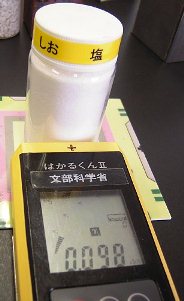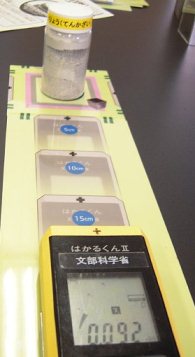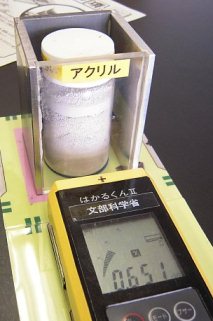Familiar type of radiation
Measurement
―Let's measure a amount of radiation with "hakarukun"―
We actually measured a amount of natural radiation which is around us with "hakarukun".
"Hakarukun" is a measuring instrument of gamma rays. We had Japan Science Foundation borrow it us.
◎Measurement 1:
Measure amount of natural radiation around our school bilding
| The measuring point | result |
| ・Rooftop | 0.028μSv/h |
| ・Classroom (4F) | 0.028μSv/h |
| ・Hall | 0.037μSv/h |
| ・Corridor | 0.056μSv/h |
| ・Underground gymnasium | 0.042μSv/h |
| ・Dumping room | 0.054μSv/h |
| ・Entrance | 0.045μSv/h |
| ・Swimming pool | 0.012μSv/h |
| ・Parking for bicycles | 0.042μSv/h |
| ・Playgroung (grassland) | 0.036μSv/h |
| ・Playgroung (soil) | 0.030μSv/h |
| ・Park | 0.027μSv/h |
| ・Road (asphalt) | 0.022μSv/h |
| ・Convenience store | 0.028μSv/h |
◎Measurement 2:Measure amount of radiation which use sumple
 We measured how many radiation have come out from familiar things, such as a ship bottom paint (additive agent), a granite (granite), sinter, a potassic fertilizer, and salt.
We measured how many radiation have come out from familiar things, such as a ship bottom paint (additive agent), a granite (granite), sinter, a potassic fertilizer, and salt.○result
the bottom of a ship material(addition)・・・1.401μSv/h
granite・・・0.089μSv/h
sinter・・・・・・・・・0.124μSv/h
potassic fertilizer・・・・・・・・0.085μSv/h
salt・・・・・・・・・・・0.093μSv/h
○about measuring materials
The bottom of the ship contained materials :
to defend against barnacles,shellfish and seaweed.Radiation from this addition makes ions so as to prevent attachment of microdes and seaweed.
・Granite.....
Granite is used in gravestones, pavement, monuments and so on.
・Sinter.....
Tamagawa hot spring's sinter is one of the radon hot springs. Sinter contains
radioactive material.
・Potassic fertilizer.....
Plants needs fertilizer to grow. "Nitrogen, phoshate, and potassium" are fertilizer's
three major elements. Especially, potassium helps the growth of vegetables.
Converting Potassium40 into potassium removes radiation.
・Salt.....
Salt is chloride sodium,however people with high blood pressure use potassium
chloride. This material is made of half chloride sodium and half potassium chloride.
◎Measurement 3:Measuring the amount of radiation at distance
 We confirmed the amount of radiation by distance on the bottom of a ship.
We confirmed the amount of radiation by distance on the bottom of a ship.○Results
・distance 5cm・・・0.557μSv/h
・distance 10cm・・・0.202μSv/h
・distance 15cm・・・0.087μSv/h
・distance 20cm・・・0.041μSv/h
A distance 5cm is used as our standard incomparison with other data・・・
・distance 10cm=two times・・・(0.202 / 0.557)=(1/2.76)
・distance 15cm=three times・・・(0.087 / 0.557)=(1/6.40)
・distance 20cm=four times・・・(0.041 / 0.557)=(1/13.6)
The results of our experimentation were effected by the inverse square law (the square of distance is in inverse proportion to the strength of radiation), but we could see a the trend.
◎Measurement 4:Measuring the amount of radiation uncler shelter Part1
 We confirmed the amount of radiation from the material shielding the bottom of a ship.
We confirmed the amount of radiation from the material shielding the bottom of a ship.○Results
(distance from materials: 5cm material shielding of 5mm thickness)
・Acrylic・・・0.607μSv/h
・Aluminium・・・・0.607μSv/h
・Stainless steel・・0.542μSv/h
・Lead・・・・・0.351μSv/h
Materials with a high density like lead have a bigger sheltering effect than lower density ones.
◎Measurement 5:Measure amount of radiation uncler shelter Part2
 We confirmed the amount of radiation with increased thickness of shielding material on the bottom of a ship.
We confirmed the amount of radiation with increased thickness of shielding material on the bottom of a ship.○Results(distance from materials: 5cm material shielding
of 0mm→5mm→10mm thickness)
・Acrylic・・・0.557→0.607→0.583μSv/h
・Aluminium・・・0.557→0.607→0.548μSv/h
・Stainless steel・・0.557→0.542→0.427μSv/h
・Lead・・・・・・0.557→0.351→0.184μSv/h
Malerials with a high density like lead have a bigger sheltering effect than lower density ones.
